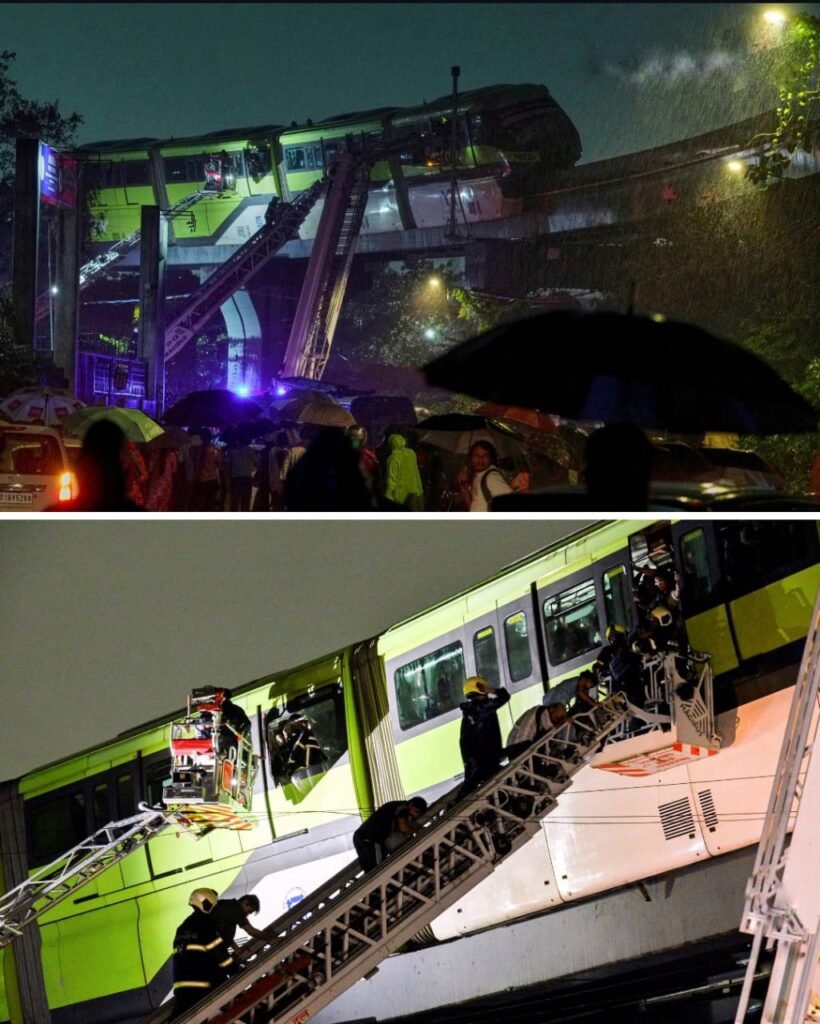Mumbai, a city defined by its relentless pace and an intricate web of public transport, was recently brought to a standstill by an incident that exposed the fragility of its urban infrastructure. On a day of heavy downpour, two Mumbai monorail trains, the city’s unique high-speed public transport system, broke down, stranding a combined total of 782 passengers. The incident, while resulting in no fatalities, served as a stark reminder of the city’s ongoing struggle with managing overcapacity and the cascading effects of extreme weather events.
As Mumbai Monorail Stalls in Rain Due to Power Snag, Rescue Operations Underway, The first and more severe of the two incidents occurred at 6:38 pm when a monorail train, carrying 582 passengers, came to an abrupt halt between Mysore Colony and Bhakti Park. The Mumbai Metropolitan Region Development Authority (MMRDA), which operates the monorail, attributed the power supply failure to “overcrowding.” A preliminary investigation revealed that the train’s total weight had ballooned to approximately 109 metric tons, exceeding its original design capacity of 104 tons. This excess weight caused a mechanical disconnection between the power rail and the current collector, rendering the train immobile. The situation was further complicated by a failed attempt to tow the stalled monorail, as its overloaded state made it impossible to move. This necessitated a three-hour-long rescue operation by the fire brigade, a testament to the unforeseen challenges posed by the incident.
Just an hour later, a second monorail, with 200 passengers on board, suffered a similar fate. It came to a halt between Acharya Atre and Wadala, and while the passengers were eventually evacuated after the train was towed back to the station, the back-to-back breakdowns painted a worrying picture. The root cause, as explained by Deputy Chief Minister Eknath Shinde, was the “diversion” of passengers from the city’s suburban trains—a result of the Harbour line closure—leading to an “uncontrolled crowding” on the monorail. This highlights a critical flaw in the city’s transport planning: the monorail, designed as a limited-capacity system for specific routes, is not built to absorb the sudden surge of heavy crowds typically handled by the metro or suburban trains.
Beyond the logistical challenges, the human toll of the incident was significant. Inside the stalled trains, panic prevailed as the AC systems failed, leading to suffocation and a sense of entrapment. Several passengers, in a state of alarm, attempted to break open the windows. While most of the 23 passengers treated for suffocation were discharged on-site, two required hospital care, underscoring the immediate health risks posed by such situations. The incident was not an isolated event; it followed a pattern of breakdowns, including an incident in August 2024 and another involving school children, pointing to a systemic problem within the monorail’s operational reliability.
The Mumbai monorail breakdown is a wake-up call for urban planners and authorities. While Chief Minister Devendra Fadnavis assured a thorough inquiry and urged people to remain patient, the incident exposes a deeper vulnerability. The financial capital’s annual battle with the monsoon rains and its impact on the city’s “lifeline”—the suburban trains—is a recurring narrative. The recent record rainfall of nearly 300 mm, which flooded streets and led to the Mithi river reaching a dangerous level, created the very conditions that strained the monorail system to its breaking point. This event underscores the urgent need for a more resilient and integrated public transport network that can withstand both the daily pressures of a mega-city and the increasing frequency of extreme weather events. The monorail, a symbol of Mumbai’s modernity, must evolve beyond its current capacity to truly serve as a reliable component of the city’s transport ecosystem.
The twin monorail breakdowns in Mumbai are more than just a series of technical glitches; they are a critical reflection of the systemic pressures facing one of the world’s most densely populated urban centers. This incident exposes a fundamental mismatch between infrastructure design and the unpredictable realities of a city like Mumbai, particularly during the monsoon season. While authorities are right to focus on the immediate rescue and inquiry, the long-term solution lies in a more holistic and forward-thinking approach to urban transit. The monorail, originally conceived as a niche solution for specific corridors, proved woefully inadequate in the face of a sudden, high-volume crowd surge. This underscores the urgent need for a cohesive and resilient public transport master plan that can seamlessly integrate different systems—from the suburban railways and metro to buses and monorail—to handle unexpected disruptions.

Furthermore, the human element of this crisis cannot be overlooked. The panic, suffocation, and fear experienced by passengers trapped inside the stalled trains serve as a poignant reminder that public safety must be at the forefront of all infrastructure planning. It’s a call for authorities to not only ensure the structural integrity and capacity of their systems but also to have robust, well-rehearsed emergency response protocols in place. The fact that the fire brigade had to be called in for a basic evacuation highlights a gap in the system’s ability to self-recover.
Ultimately, the monorail incident is a microcosm of Mumbai’s broader urban challenges. It reveals the city’s vulnerability to extreme weather and the ripple effects it can have on daily life. As climate change intensifies and monsoons become more erratic, Mumbai’s transport network must be made “monsoon-proof.” This requires significant investment in upgrading infrastructure, improving drainage, and building a network that can absorb and reroute traffic in a crisis. The inquiries and assurances from government officials are a start, but they must lead to concrete action. The future of Mumbai’s public transport system depends on its ability to learn from this event, not as an isolated failure, but as a critical lesson in designing a truly resilient, safe, and efficient urban lifeline.